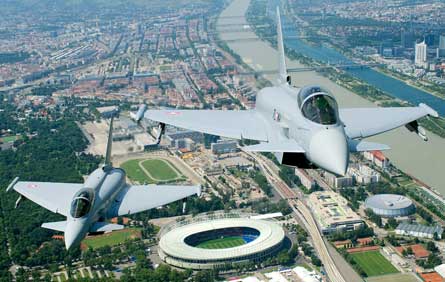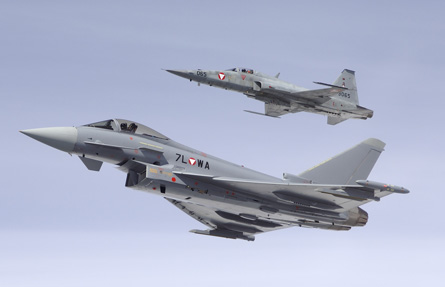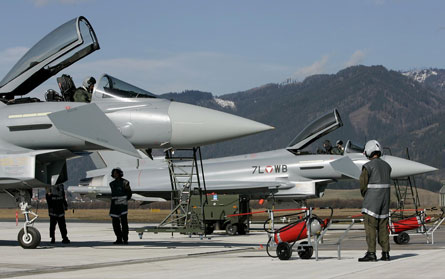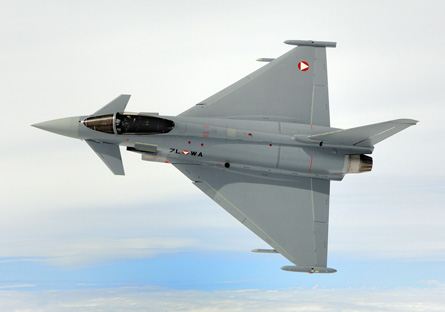To describe Austria's selection, purchase and introduction of the Eurofighter Typhoon as merely "controversial" would be a spectacular understatement.
Chosen by the neutral nation in 2001 to replace its air force fleet of 23 Saab Drakens, the originally €2 billion ($3.1 billion) deal has so far been the subject of more than 4,600 parliamentary questions, and is now undergoing its fifth audit. Former air force commander Maj Gen Erich Wolf also lost his job over the contract last year, amid allegations of financial links between his wife and an EADS lobbyist.
The programme has also survived threats from Austria's Social Democratic Party, which became part of a coalition government in early 2007 after campaigning on a pledge to terminate the deal, even though production was at an advanced stage. But after reviewing the terms of the contract, the deal was instead renegotiated from 18 to 15 single-seat aircraft, shaving an expected €370 million off the project total.
Flight International visited Zeltweg air base in early July, one week after Austria began air policing duties using its first eight Typhoons (two aircraft pictured over Vienna, below).
 |
|---|
© Markus Zinner/BMLV |
Despite the turmoil that continues to surround the acquisition, Brig Erwin Jeloschek, programme chief for air force matters within the nation's Joint Forces Command general staff, says: "We are very proud to have achieved this capability with a fourth-generation fighter in less than 11 months."
Describing much of the domestic controversy as the result of "half-truths and gossip", he continues: "We have had this fight for seven years. It was often a painful process, but we have been able to create a stable environment for this marvellous aircraft."
Austria's first Typhoon arrived at Zeltweg on 12 July 2007, after undergoing final assembly at EADS's Manching site near Munich, Germany. Its arrival came less than three weeks after contract renegotiations had been completed with the four-nation Eurofighter consortium.
Achieved on 1 July during the Euro 2008 football championships hosted by Austria and Switzerland, the Typhoon's air policing debut coincided with the end of a lease agreement that had seen Vienna operate Swiss-owned Northrop F-5 interceptors (one pictured below with Austria's first Typhoon) following the Draken's retirement in late 2005. The first four of its aircraft were returned to Payerne air base on 30 June, with eight more to follow.
 |
|---|
© Eurofighter |
Two Typhoons and one reserve are at readiness, armed with internal Mauser 27mm cannon and Diehl BGT IRIS-T short-range air-to-air missiles. Raytheon's longer-range AIM-120 AMRAAM was also originally planned for integration, but the requirement was deleted under the contract renegotiation.
While NATO nations typically maintain the ability to scramble quick reaction alert aircraft within 15min, Austria aims to achieve a target of 7min. "In 15min the threat will no longer be in Austrian airspace," says Brig Gen Karl Gruber, chief of air staff within the Joint Forces Command, who says a response time of 9-10min has already been demonstrated.
Austria's air policing task differs markedly from the air-defence mission last held by its air force in December 2001. "The classical air defence role is not our mission: the first goal is within-visual-range," says Gruber, who adds that restoring this capability would require a fleet of more than 24 aircraft.
Under original acquisition plans, 24 new fighters and six two-seat trainers were to have been acquired, and Jeloschek concedes that the introduction of an all single-seat fleet "is one weak part" of the Typhoon procurement.
 |
|---|
© BMLV |
"For air policing the decisive factor is the number of pilots," says Gruber. Austria early last month had six pilots with limited air policing clearance, including four trained in air-to-air gunnery. Four more will follow this year, after receiving instruction at Germany's Laage air base, and the total will increase to 18 in 2010, beyond which two new pilots will convert to the Typhoon per year.
Austria's Eurofighter structure will see aircraft assigned to two squadrons within its 1st Fighter Wing at Zeltweg, which is undergoing infrastructure investments of over €100 million, but these will effectively operate as a single unit in peacetime. A ninth aircraft was delivered in mid-July, with three more to follow by year-end and the last to arrive in March.
Full operational capability will be declared in July 2009, although Gruber says the nation expects its air policing service to be fully established within "maybe six or eight years". It intends eventually to operate up to six Eurofighters from a site near Linz in the north of the country for several weeks a year.
Operations of the Typhoon represent the high end of a tiered approach to ensuring airspace control, which also comprises armed Saab 105 and Pilatus PC-7 turboprop trainers, gun-equipped Bell OH-58 Kiowa helicopters (below) and a ground-based air defence network. The Partnership for Peace nation in June opened a new air operations centre in an underground facility 60km (37 miles) south of Salzburg, and is linked to NATO's air defence network.
 |
|---|
© BMLV-HBF |
Plans are also being drawn up to buy a small fleet of new advanced jet trainers that will both download hours from the Eurofighter and deliver a secondary air policing role.
Gruber says Austria typically encounters "one or two aircraft a week with no radio communications", and says Typhoons were called into action twice in late June while performing training flights ahead of their formal air policing debut.
Wider interoperability is an issue for Austria's Typhoon force, although it is planned to receive a Link 16 upgrade within the next two years under a complicated acquisition of multifunctional information distribution system equipment from the USA. Jeloschek expects the purchase to be completed following a process lasting around five years, which he describes as "one of our biggest fights. NATO is an excellent organisation: but only for NATO countries," he notes.
Current laws restrict Austria from deploying the Eurofighter beyond its national borders, but Gruber says he hopes from 2010 to revive the Amadeus series of exercises - last staged by the country in 2002 - to enable the type to participate in multinational training activities. "Only by exercising can you reach the capability," he adds.
Looking further ahead, Jeloschek says Austria must remain flexible on the long-term use of its Typhoons, and says: "We have to be prepared to change the role." However, introducing a wider capability could take between seven and 10 years to implement, he adds.
Austria's original, 18-aircraft contract included an option to modify its aircraft to the Tranche 2, Block 8 configuration, but its smaller fleet has instead been capped at the Tranche 1, Block 5 standard. Equipment such as a full defensive aids suite and the Pirate infrared search-and-track sensor have been omitted, limiting their operational standard, although chaff and flare dispensers are retained.
 |
|---|
© Markus Zinner/BMLV |
While they will be "logistically equal", the nation's fleet is being acquired from a dizzying array of sources to meet its delivery requirements as the Eurofighter programme's first export customer.
Six late Tranche 1 production slots were identified among the four partner nations to resolve this issue, with two sourced from both Germany and the UK and one each from Italy and Spain. The countries will receive replacement aircraft during Tranche 2 production.
A further three new Tranche 1 aircraft originally set for delivery to Germany are now going to Austria, along with six already delivered examples, each with fewer than 170 flight hours logged. The first used aircraft will be delivered in October, followed at a rate of one a month.
Austria had logged almost 280 flight hours with its Typhoons by mid-July, with this representing a small fraction of the 42,000h flown by the Eurofighter partner air forces. Vienna expects its fleet to eventually deliver 1,500h a year, supported by 40 simulator sorties per pilot (below). "The stress for the moment lies on the training in the full-mission simulator," says Karl Hofer, Eurofighter programme manager within the nation's defence ministry.
 |
|---|
© BMLV-HBF |
Standing in-service support contracts include 3.5-year deals for aircraft systems, spare parts and training systems with EADS and Eurofighter, plus a seven-year package for the type's Eurojet EJ200 turbofan engines. Scheduled on-aircraft maintenance will be conducted at Zeltweg, with each aircraft to return to Manching for inspection after 800 flight hours.
Savings of around €500 million have been targeted from the lower operating costs associated with Austria's downsized fleet, and Jeloschek notes that the Eurofighter launch nations are also now targeting a 40% reduction in running costs. Information from Zeltweg is already being exchanged with the partners.
"We have contact with the air force chiefs and aim for the deepest co-operation on operations, logistics and training," says Jeloschek. "We are looking to narrow the gap in information as the youngest Eurofighter nation."
Source: Flight International
















